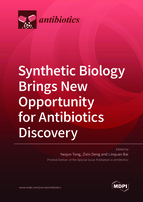Synthetic Biology Brings New Opportunity for Antibiotics Discovery
A special issue of Antibiotics (ISSN 2079-6382). This special issue belongs to the section "Biosynthesis and Combinatorial Approaches in Antimicrobial Discovery".
Deadline for manuscript submissions: closed (10 September 2022) | Viewed by 25257
Special Issue Editors
Interests: Crispr; microbiology; natural products; synthetic biology; cell factory
Interests: synthetic biology; natural products
Special Issue Information
Dear Colleagues,
Though society is developing much more rapidly today than it did in the past, we are facing a complicated public health issue in the form of global drug shortages, and antimicrobials are unfortunately on that list. These shortages are caused by various issues, e.g., technological limitations, which have led to a drying up of the pipeline of antimicrobial development. Indeed, it has been decades since antibiotics with a completely novel mode of action were last delivered to the clinic. The limited availability of antibiotics, in addition to the rapid emergence of multidrug resistance, are putting us in a very dangerous position. Luckily, the advances of new technologies, especially biotechnologies, such as DNA sequencing, precise genome editing, system metabolic engineering, multiomics, synthetic biology, big data processing, and artificial intelligence are offering a great opportunity to develop better and efficient bioactive molecules, including next-generation antibiotics. Currently, various achievements and new discoveries from both academia and industry are taking place in the broad field of antibiotics, which reflects the fact that a new era is coming. As one of the most important driving forces, academia plays a critical role in drug discovery for a safer society, and thus, we would like to bring academia, industry, and clinic together in this Special Issue to report recent progress in antibiotics discovery.
Prof. Dr. Yaojun Tong
Prof. Dr. Zixin Deng
Prof. Dr. Linquan Bai
Guest Editors
Manuscript Submission Information
Manuscripts should be submitted online at www.mdpi.com by registering and logging in to this website. Once you are registered, click here to go to the submission form. Manuscripts can be submitted until the deadline. All submissions that pass pre-check are peer-reviewed. Accepted papers will be published continuously in the journal (as soon as accepted) and will be listed together on the special issue website. Research articles, review articles as well as short communications are invited. For planned papers, a title and short abstract (about 100 words) can be sent to the Editorial Office for announcement on this website.
Submitted manuscripts should not have been published previously, nor be under consideration for publication elsewhere (except conference proceedings papers). All manuscripts are thoroughly refereed through a single-blind peer-review process. A guide for authors and other relevant information for submission of manuscripts is available on the Instructions for Authors page. Antibiotics is an international peer-reviewed open access monthly journal published by MDPI.
Please visit the Instructions for Authors page before submitting a manuscript. The Article Processing Charge (APC) for publication in this open access journal is 2900 CHF (Swiss Francs). Submitted papers should be well formatted and use good English. Authors may use MDPI's English editing service prior to publication or during author revisions.
Keywords
- Antimicrobial
- Antibiotics
- Antivirus
- Bioactive natural products
- Multidrug resistance
- Biosynthesis
- Metabolic engineering
- Synthetic biology
- Advanced biotechnology
- Microbial cell factory









